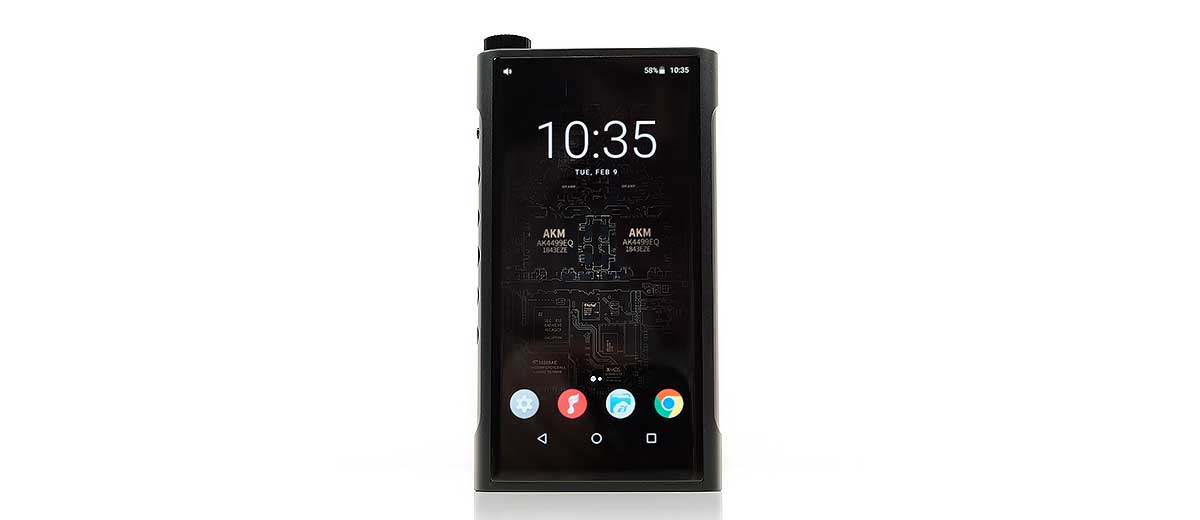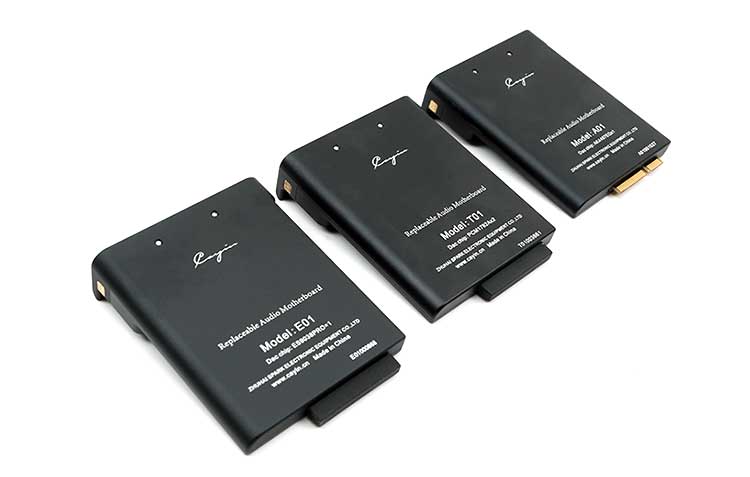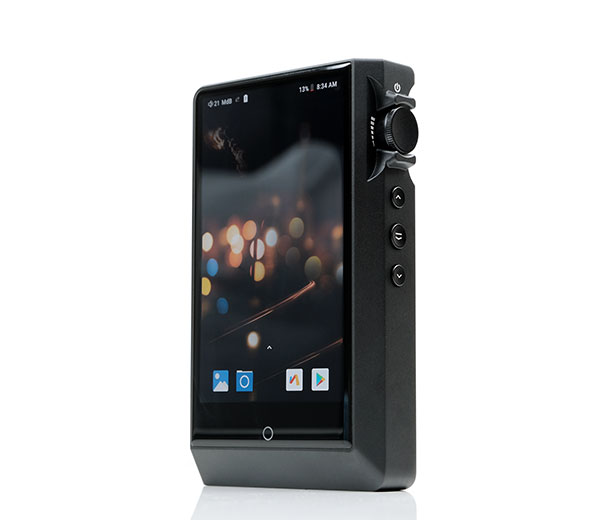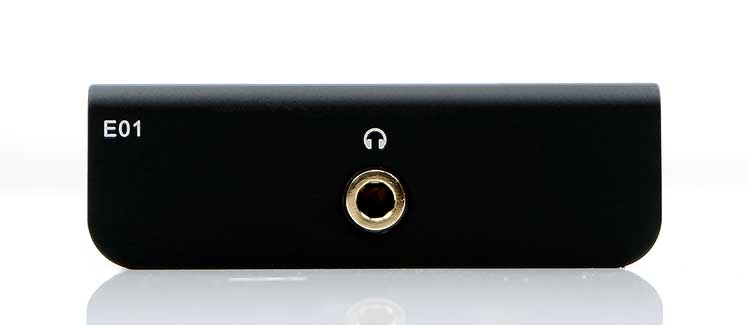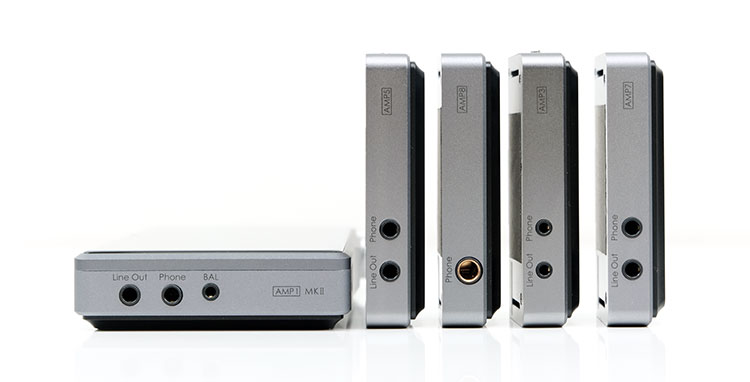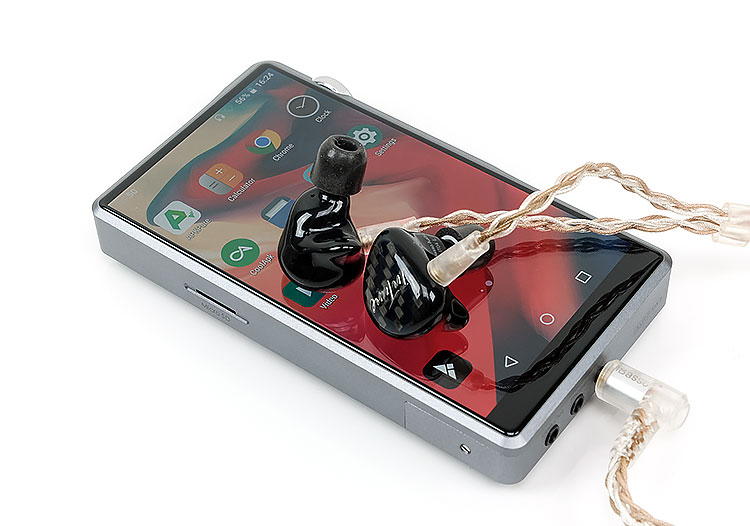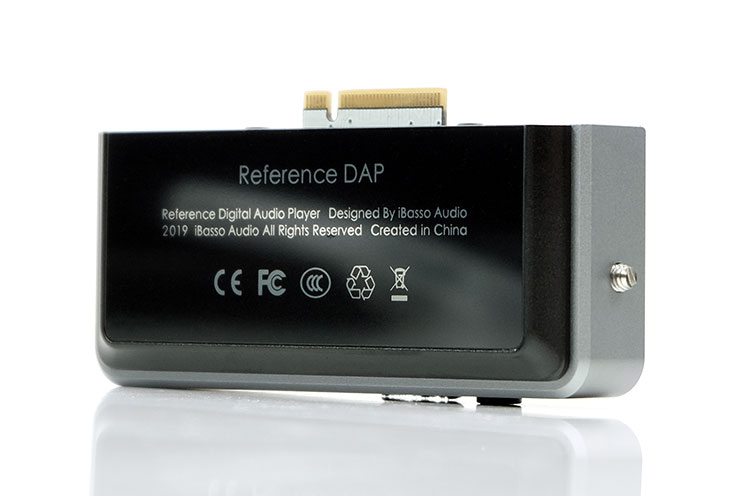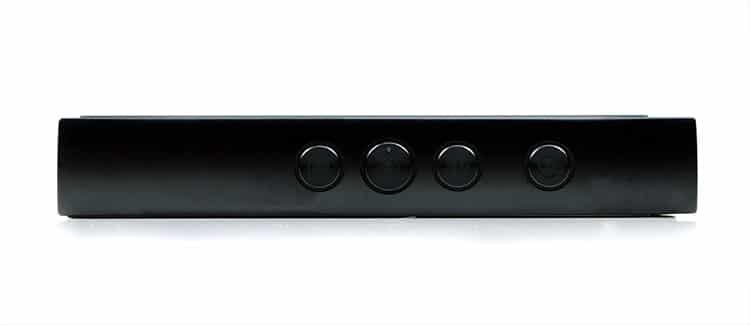FiiO M15 Select Comparisons
(All comparisons were done using Campfire Audio’s Andromeda, 64 Audio’s Tia Trio, and Final’s D8000 Pro.)
Cayin N6ii
$1299
The N6ii was launched in 2019 and apart from the Android Framework, it is very distinct from the M15 in design and purposing. Essentially, the N6ii is just a transport with swappable motherboards. What that means is that the amplifier and DAC implementation are housed in modules that are swappable. Thus, the N6ii player is more the processes and user interface.
That is pretty much the opposite of how the M15 is set up with everything integrated tightly. FiiO did have the amp card system on their previous X7 series but that has been replaced now by single ‘do-it-all’ units.
Processing
That does make it hard to do a direct internal comparison but from the player perspective, both are set up very differently. The N6ii uses an Arm Cortex-A53 64BIT 4-core CPU. Now, these chipsets are not as fast as the M15 Samsung CPU but it performs well compared to other DAPs such as the iBasso DX220.
The clock rate is set to a max of 1400Mhz which is somewhat lower than the M15’s 1976Mhz max clock level and you can feel that when you start using resource-intensive apps. From boot to touch response the M15 does feel the faster of the two, almost like a smartphone experience.
One thing to note, however, is the RAM. The N6ii uses 4GB of RAM compared to the 3GB inside the M15. That will help keep the N6ii response rate under heavy loads competitive with that older chipset as well as improve buffering speeds for the likes of DLNA streaming.
DAC
This is one versus many with Cayin offering 4 different amp/DAC solutions compared to the fixed singular amp/DAC of the M15. However, the M15 DAC is top tier with the use of a dual AK4499EQ implementation which is superior on paper to Cayin’s A01 and T01 which use a dual AK4497EQ, and in the T01, a much older PCM1792A DAC.
The N6ii pulls up to a more competitive level with its motherboards with the E01 and E02. The E01 uses a single ES9028PRO and the E02 a dual ES9038Q2M DAC implementation. I have not yet tested the E02 but the E01 is a big upgrade on the A01 and T01.
Decoding for the N6ii is a maximum DSD256 and PCM 32BIT/384kHz with almost every codec except MQA covered. The M15 will go higher at DSD512, PCM 32BIT/768kHz as well as 8X MQA decoding.
Amp
The E01 and E02 actually house two amplifier modes, Class A and Class AB so you do get more flavor for your amp than the M15. That being said the E01 is single-ended only and more for easy loads and sensitive gear whereas the E02 has more power, is 4.4mm balanced, and is suited to headphones.
These cards are not cheap either so the cost of owning two plus the DAP is closer to $2k. The M15 can offer both balanced and single-ended power for both sensitive and harder-to-drive headphones without any additional cost.
The A01 and T01 are pretty close in terms of THD+N numbers but they do not have the same power range into a 32Ω as the M15.
The E01 has the least power but specifically for sensitive gear and may be more suitable than the M15 for the likes of Campfire Audio IEMs. The E02 comes the closest to the M15 top-end 800mW balanced at 600mW but both E-series motherboards have much lower THD+N performances.
OS
The N6ii uses Android 8 or Oreo with Google Play out of the box. The M15 is a step behind with Android 7 or Nougat but now has the same Google Play Framework.
The OS setup on the Cayin, especially with the E01/E02 motherboards feel more adept at working with the overall tuning whereas the M15 is about connectivity. That means you have more quick access for features like Amp mode selection and a 3-step gain. The M15, though it allows quick access to filters, also prioritizes vehicle, wireless, and BT connectivity.
Beyond that, the feature set is quite similar between the two DAPs. The only major differences between them are the screen size, which is in favor of the bigger M15, and its faster CPU allowing for a snappier OS response.
Design
From a design perspective, the N6ii is lighter but only by 20g. What makes it seem easier in the hand is the stubbier design. The M15 is very tall compared to the shorter but thicker N6ii. Most will find the N6ii much easier to work with one hand than the M15.
The M15, however, does make quick physical button handling somewhat easier by placing them on the left beside your thumb if you are using it in your left hand. The buttons and volume on the N6ii are on the other side.
Performance
This will depend ultimately on the motherboard you are using with the Cayin N6ii so it is a little easier to summarize each one briefly as follows.
E01
The E01 Class A/B amp mode has a more immediately noticeable low-end weight and enhanced richness added to our paired gear, particularly the Andromeda. The M15 is more controlled and sounds the more neutral of the two sources. The E01 sounds more intimate, vocals a bit further forward, and fuller sounding. The M15 is taller, more ethereal, but also more complex sounding.
Neither lack resolution, however, the M15 does have an airier presentation with treble having a bit more presence that adds a little more odd-harmonic crispness to the timbre. By contrast, the E01 Class A/B is more even-harmonic or euphonic in overtone.
The M15 tone is a lighter touch and not as thick or organic sounding as the E01 Class A/B. The M15 may seem to lack a bit of PRaT with a presentation that is more about articulation and complexity than ‘verve’.
Some might argue that is ‘character’, however, for me, it is more about that bass weight up to the lower-mids and the E01 has more of it whereas the M15 offers more detail beyond 2-3k.
When you switch to Class A on the E01 you lose a bit of the punch and drive of the AB and it starts to veer a little more to the romantic side. Here, the M15’s superior detail and separation had an edge on the overly smooth approach of the E01 Class A mode. It sounds tighter and it’s equal in terms of bass weight and more extended and articulate into the mids and treble.
A01
The A01 has the warmth of the E01 but lacks the punch and dynamic range so it sounds fuller and smoother than the M15 but not as well separated or as detailed. The AK4497EQ DAC chipset has always felt a shade subdued for me and the A01 does little to dispel that feeling.
The M15 sounds more articulate and complex in its imaging though also more neutral and cleaner in its timbre. The low-end is tighter, snappier, and with better layering, whereas the A01 lengthens the decay and adds a bit more bloom into the lower mids.
Vocals on the A01 are to the euphonic side and even-harmonic dominant though not too rounded or soft in their delivery. The M15 is more neutral, drier, and slightly cleaner with a little more natural sibilance shining through.
The top-end on our gear also sounded more relaxed on the A01/N6ii combo whereas the M15 extended better with an airier sound. You do get a little bit more upper-mids emphasis on the M15 also so not quite as wet in percussion notes compared to the A01.
T01
The M15 is more resolving and articulate and delivers an enhanced level of treble extension compared to the T01’s more intimate mid-centric tone.
The T01 has a bit more emphasis on producing a natural to sweet timbre that fattens up the vocal texture a bit more whereas the M15 sounds more neutral and slightly lighter in its delivery. Whilst I would term the T01 as more linear and brighter sounding than the A01 it does carry a bit more bloom and warmth into the mids than the M15.
Not that the M15 is a dry sound by any means but it definitely has a cooler timbre than the T01. Odd-harmonic overtones do creep in a bit more on the M15 but its more of an accuracy thing to me as the T01 sounds the softer of the two.
iBasso DX220
$899
In some ways, the DX220 mirrors the Cayin N6ii and definitely the older FiiO X7 MKII in terms of how it operates as a DAP.
The DX200’s use of an interchangeable amp card system is a continuation of the DX200 series amp card series and a direct competitor to the X7ii card ecosystem. FiiO has dumped that for their DAPs and the M15 amp is built-in. iBasso has stuck with it though their mid-fi DX160 and new X200 MAX do not use amp cards.
So, beyond the DAC, the flavor of the DX220 in terms of output performance and final sound coloration will largely depend on the amp card you have inside it. There are 9 cards to choose from historically and 5 currently for sale, 3, 7, 5, 8, and the Korg NuTube card, the AMP9.
The usual cost is around $199 per card so with the base price of $899 getting you the DAP and AMP1 MKII you can afford another 2 cards to match the price of the M15. That might be attractive to some readers.
DAC
The DAC on the other hand is fixed. The DX220 uses a dual ES9028PRO which is roughly a tier lower than the new AK4499EQ inside the M15.
The decoding capability of the DX220 is very competitive. Both the M15 and the DX220 can do MQA though only at 4X for the DX220 and 8X for the M15. That means the M15 can unfold to a higher sample rate than the DX220.
Top-tier sampling rates for the DX220 include DSD512, the same as the M15 though its PCM rate is lower at 32BIT/384kHz compared to 32BIT/768kHz on the M15. Both cover the same wide range of codecs from DSD down to FLAC and lossy MP3.
Amp
iBasso amp cards specs are always a little tricky to read as they work on Vrms and how they calculate loads in mW is not as straightforward as you think because of the way they set up their voltage and current designs.
If we stick strictly with the stock amp, the AMP1 MK2 then the output unbalanced is 3.1Vrms and balanced 6.2Vrms balanced. A normal conversion slide of rule would place that at balanced 1W into a 32Ω and about 320mW unbalanced.
However, speaking with iBasso I know that is not quite the case and more likely to be around the 500-600mW marker at the absolute highest level. It is unlikely the amp card would hit FiiO’s balanced max of 800mW into a 32Ω load. Since Amp 8, the next most powerful amp card to the AMP1 MKII has a similar 6.2Vrms rating you can apply the same measure here also.
What iBasso do very well, however, is on THD+N numbers with most of their amp card numbers doing better than the M15. AMP1 MKII is rated at -0.0002% on a 32Ω load and AMP 8 is -0.00023% on a 300Ω load. The M15 amp, by comparison, is somewhat lower at <0.0005% (1kHz/32Ω) unbalanced and <0.0006% balanced (headphone output activated).
OS
The DX220 does use Oreo compared to the older Nougat on the M15 with more RAM also at 4Gb compared to just 3GB.
However, the real bottleneck is the processor. The DX220 uses the same processor as the Cayin N6ii, an ARM Cortex-A53 64BIT 8 core with a top-level clock speed of 1008Mhz. The M15’s Samsung processor is double the speed at over 1900Mhz and you can feel the difference immediately with the DX220 feeling a lot laggier.
Both original came without Google Play, but now the latest firmware on the M15 allows for the Google Play Framework whereas the DX220 official firmware still does not use it. You will have to use APK Pure which is great for avoiding regional app locks but not so good for apps that need the Google Play framework to function.
Both have their own apps, Mango for the Dx220 and FiiO Music for the M15. I do love Mago’s superior audio features such as the 3-step gain and the excellent PMEQ. It also does a better job at OTG media integration. However, the FiiO Music app is more mature for BT and generally offers a slicker navigation.
Design
The DX220 is a little bit shorter but for my money, it has the more glamorous screen with a 1080p resolution capability compared to just 720p on the M15.
The M15 is taller at 5.15″ compared to just 5″ so there is some additional benefit there in terms of scrolling real estate. You can drop the 1080p down to 720p on the DX220 which I do advise as the higher resolution drains the battery a lot faster.
The DX220 is also a lot lighter at 240g compared to the M15’s 310g. You will feel that difference in the band with the DX220 being much easier to manage. I think both have a nice design though the DX220 analog volume control is gimped by a poor leather case design. At least it has a leather case. The M15 case is optional which I would have preferred to have seen come in the box.
In terms of IO, only the AMP 8 comes with 4.4mm balanced, the rest use 2.5mm TRRS or just 3.5mm depending on the card you pick. The M15 uses all normal output configurations so there is a high degree of flexibility there.
OTG digital audio is also more stable on the M15 compared to the DX220. Not everything is OTG compatible with the DX220. Both DAPs offer an internal memory of 64GB with a single external memory card slot. Battery life is massively better on the M15 at 15 hours compared to the DX220’s modest 7-8 hours.
Stock Performance
The stock AMP1 MKII is a bit closer in the overall presentation to the M15 the N6ii motherboards. Both are relatively neutral, expansive, and very good in terms of resolution and complex staging. They are both less emotive than the Cayin motherboards and strip a little weight in exchange for resolution and clarity.
There are some differences, however, that make them fairly easy to A/B. The first is the low-end into the lower-mids. The AMP1 MK11 heads a little more mid-bass bloom that comes into the midrange timbre a bit more whereas the M15 is a little lighter and cleaner. Of the two, the AMP1 MK2 sounds marginally the more planted of the two sounds with a bit more weight in its delivery.
The AMP1 MKII also has a wetter timbre with a bit more smoothness in its delivery. It pulls from that slightly warmer low-end to get there but it seems the top-end is not quite as pushed as the M15’s treble tuning.
Of the two, the M15 comes across as a bit brighter but not ‘bright per se’. That is the second big difference between the two amps.
You hear more emphasis in the odd-harmonics of the M15 with the Andromeda and tia Trio monitors compared to the DX220 AMP1 MKII. That means more percussion bite but also a slightly leaner note. The AMP1 MK2 loses a tiny bit of bite but introduces more body to its notes. That same pattern continues into voicing where the M15 is cleaner but also a litter lighter in sound.
AMP9
I have to point out right away that the noise floor on the AMP9 is much too high for a lot of sensitive IEMs. Compared to the M15, the AMP9 has a massively higher noise floor which counts out the likes of the Andromeda.
Compared to the M15, the AMP9 is warmer, richer, and more analog sounding but also less resolving with more of a relaxed approach. That should not be surprising considering the Korg NuTube is in the middle of this card. It brings a stronger sense of PRaT and a certain smoothness, particularly vocals that Cayin house sound fans will greatly enjoy.
However, if you need that blacker background, better power output, and a cleaner more detailed sound then the M15 is the way to go. The M15 will not sound as planted with a more linear low-end and the timbre will be much more neutral but beyond that, you get a lot more clarity and detail, particularly in the mids and treble.
This is where the M15 pushes ahead both in terms of staging complexity and imaging accuracy as well as top-end perceived articulation.
Lotoo PAW 6000
$1200
Technical
The PAW 6000 is generally seen as a junior PAW Gold TGouch and with good reason. It is cheaper, which is always a plus, and has a similar form factor and design of the bigger DAP as well as using the same OS. The price at $1200 makes this a viable alternative to the M15 and it does offer a very different experience also.
DAC
The DAC inside is a little on the lower end compared to the M15’s dual AK4499 implementation though it is the same DAC inside the PAW Touch Gold and it is still an excellent performer. The PAW 6000 uses a single AK4493EQ which is the same setup as the M11.
Decoding is competitive at up to DSD256 and PCM384kHz 32BIT with no MQA capability. However, it is behind the M15’s DSD512, PCM 32BIT/768Khz, and MQA 8X capability. How much value you put into that is anyone’s guess since most tracks will be about DSD64 downwards at a commercial level.
Amp
The PAW 6000 offers both balanced and unbalanced with 4.4mm and 3.5mm TRS much like the M15 but it does not offer 2.5mm TRRS.
Both sockets have a similar output rating at 300mW into a 32Ω load and cannot compete with the 800mW 32Ω top-rated output level of the M155 balanced over-ear headphone output mode. The M15 is the better option for powering demanding headphones.
However, for sensitive gear the PAW 6000 amp output stage is very low with an almost pitch-black background. The noise numbers are better than the M15 also with a THD+N of 0.00025% unbalanced and an even lower 0.0002% for balanced compared to the 0.0009% of the M15’s amp stage. This may well be the PAW 6000’s competitive edge over the M15.
OS
The Lotoo PAW 6000 uses a non-Android OS, one they developed in-house called LTOS. It is pretty much the same OS as the one installed on their flagship PAW Gold Touch. It is nowhere near as engaging as the M15 Android OS and you cannot install apps or go beyond it being a pure music player.
However, it’s super-fast with a 2s boot time and very consistent in terms of its GUI to user interaction. I rarely find that it lags, becomes unstable, or freezes. OTA updates are available via limited WiFi and they are lightweight at under 50MB per firmware.
The OS does have some excellent features including their brilliant PMEQ system and some DSP filters that I actually use. The PAW 6000 will also transmit BT LDAC but like the M15 it is just BT4.2 and the range isn’t that great. In fact, our TWS testing showed up a lack of stability with the PAW 6000 for connections that even the M15 can cope with.
Design
The PAW 6000 design is discreet and much smaller or lighter than the M15. It is a mini PAW Gold Touch in many ways with the protected analog gold dial and Sony-like boxy design and physical button interface. The screen is much smaller at just 3.77″ but it does not need to be bigger since you are not running apps on it.
Battery life is similar at 15 hours apiece and the battery inside the Lotoo is much smaller at 5200mAH compared to the big 7490mAh inside the M15. Granted, the PAW 6000 OS uses far fewer resources and the amp is weaker so that will go some way to lengthening the battery life. The lack of apps will also mean you get a consistent battery performance from cycle to cycle.
One major drawback is the lack of onboard memory in the PAW 6000. It is a single microSD slot only. Something I have never really understood, why Lotoo leaves out onboard memory. Like the M15, it will, however, take OTG flash expansion as well as OTG digital audio and work as a USB DAC.
Performance
The PAW 6000 is very competitive when compared against the M15’s performance. The dynamic range is very similar but what sets these two apart is the greater emphasis the Paw 6000 gives to the low-end and how expansive the staging is towards the top end for the M15.
From what I pick up with both the Andromeda and the tia Trio, the PAW 6000 has a bit more weight below 100Hz whereas the M15 sounds more faded, more linear, and flatter. I think the M15 low-end definition is very tight but it is a drier hit and slightly lighter also. The PAW 6000 is a bit closer and denser sounding and you can hear that clearly with bass guitar plucks and bass synth passages.
That pulls the staging down a bit and makes the PAW 6000 sound the deeper and more powerful of the two sources. The M15, on the other hand, sounds the more neutral and the airier of the two DAPs. It extends a bit more from the mids up into the treble with more perceived headroom or height. Vocals also have a bit more space to breathe but do not sound as rich as the PAW 6000.
Our Verdict
The FiiO M15 has a lot for going for it, and when I say a lot, I mean almost everything you could want in a modern portable audio player.
The additional power output capacity makes this one of the first Android DAPs that I can truly feel comfortable pairing with some decent full-sized headphones. And yet, its noise levels are very low indeed to work just fine with sensitive monitors.
The M15 covers a very wide range of headgear indeed, one of the widest on the market today. When you consider it houses all of the most popular jack formats it really does offer one of the best ‘plug and go’ experiences out there.
Nothing is perfect, no DAP is. I would love to have seen an Oreo bit-perfect framework implementation for all apps and MQA 8X decoding beyond the FiiO Music player. Bluetooth 5.0 would have been ideal also. A proper screen protector and included leather case would be very useful for protection from day-to-day use.
Slowly, but surely, however, FiiO seems to be knocking down my issues with newly released firmware. Google Play is there and that is a big plus. The incredible speed from the M11 remains so it is the fastest DAP in the market also.
All that remains is the sound. You will have your preferences. It won’t convert Cayin house sound fans, it just doesn’t do that ‘tube-like analog sound’ at all. This is a neutral to natural sound with a whisper of treble brilliance, an exposition on detail where articulation is key. This is a reference sound that, to date, is about as mature as it gets for FiiO.
FiiO M15 Technical Specifications
- Dual Flagship Dac setup AK4499EQ
- Lightning Fast SoC Exynos 7872 Processor
- 3GB Ram
- 64GB in-Built storage expandable with up to 2TB memory card
- 5.15″ HD display(720P) with 18:9 support with Corning Gorilla Glass
- 2.4/5GHz dual-band Wi-fi Support
- 7490mAh Battery with 15 hours of Music Playback
- 2.5mm balanced, 3.5mm, and 4.4mm balanced
- Qualcomm Flagship Bluetooth Chip CSR8675 with two way LDAC Bluetooth
- Two Class-Leading Femtosecond Crystal Oscillators from NDK, Japan
- XMOS XUF208 Control Chip which supports direct decoding 768kHz/32bit, Native DSD512 support
- Fully Decode (8x) Original MQA Files
- Professional ADC Volume Adjustment Mode
- CNC Machined Aluminium-Magnesium Alloy Chassis
- Five Physical Buttons with Customizable Functions
- Solid North American Black Walnut Wooden Enclosure
- Independent “HOLD” Switch, PCB Coated with Graphite and Thermally Conductive Silicone Grease
- All to DSD 2nd Gen
- One-click Standby Mode
- 21W Dual Quick Charging
- Android / Pure Music / USB DAC
- FiiO Link, DLNA, AirPlay, WiFi Song Transfer support
- FiiO Original Music APP
- Weight 310g
- Dimensions 134mm x 75mm x 18mm
Click here to see the full rundown of the M15 Specifications

